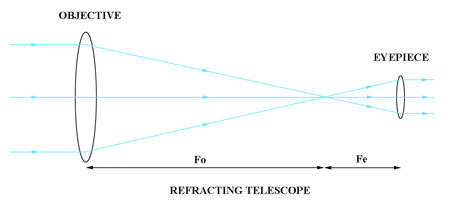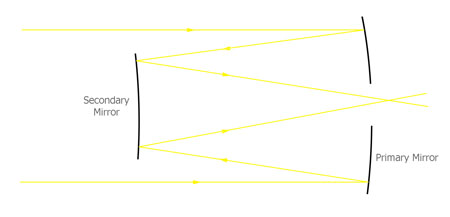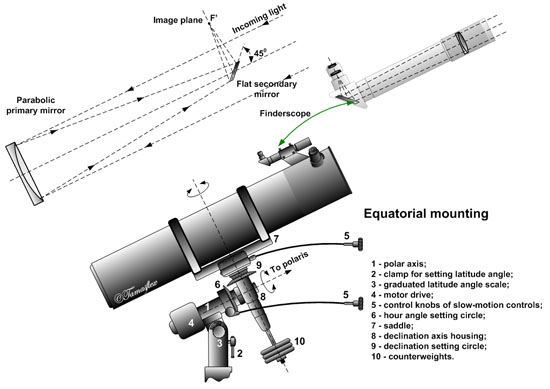Basic refracting astronomical telescopes consist of two lenses. The objective is the large light-gathering lens located at the skyward end of the telescope. This lens brings the image of a distant object to focus at its focal length, a plane close to the smaller end of the telescope. The eyepiece is a simple magnifying lens used to enlarge and view the image formed by the objective. The overall length of the telescope is determined by the sum of the focal lengths of the two lenses. The telescope gives the observer an inverted image and is consequently not very convenient for terrestrial purposes, but viewing inverted celestial bodies is quite normal.

Refracting telescopes are often described in terms of the focal length and aperture (diameter) of the objective (refracting lens). A 1200 x 127 refracting telescope therefore has a 1200 mm focal length and a diameter of 127 mm. The magnification of the telescope is given by:
M = Fo / Fe
where M is the magnification, and Fo and Fe are the focal lengths of the objective and eyepiece lenses respectively.
The comparatively simple design of a basic refracting telescope, incorporating two lenses mounted in an enclosed cylinder, means that little maintenance is required. Local seeing problems associated with tube currents are virtually eliminated by the sealed body of the telescope. However the optics of a refracting telescope rely upon the bending (refracting) or light and this is not a perfect process. The degree of bending depends upon the refractive index of the glass used, and different wavelengths are refracted by slightly different amounts. It is consequently impossible with a single lens to bring all visible wavelengths to sharp focus at the same point. The result is that some elements of an images are slightly out of focus, leading to degradation of the image and colour halos. However, in general, a 4" - 6" refracing telescope provides good high-contrast images suitable for lunar and planetary work.
The introduction of compound lenses, where the single-lens objective is replaced by a group of two or three lenses having different refractive indices, improves upon the basic refractor design to a significant extent. A two-lens combination, consisting of a concave flint glass element and a convex crown glass element, and known as a doublet achromat, brings more visible wavelengths to a common focus and so produces sharper images. Triple-lens apochromats, manufactured using high-quality ED (extra low dispersion) or fluorite glasses, provide further improvement and even sharper images but also attract higher prices.
In a reflecting telescope, the principal light-gathering element is a concave parabolic mirror which is normally found at the bottom end of a skyward-pointing instrument. Light enters the open top end of the tube, and is reflected by the mirror before creating an image at the focal plane. The distance from the mirror to the focal plane is known as the focal length of the telescope. In some cases, a secondary mirror is positioned close to the focus at the top of the tube, and is used to redirect the light to an eyepiece, film or sensor.
Reflecting telescopes solve the problems of color correction exhibited by in refractoring instruments because a mirror focuses all visible wavelengths of light at a common point. The primary mirror is normally manufactured from glass and then coated with vacuum-deposited aluminium.
Various best-known types of reflecting telescope are:
|
|
| By Szőcs TamásTamasflex (Own work) [CC-BY-SA-3.0 (www.creativecommons.org/licenses/by-sa/3.0) or GFDL (www.gnu.org/copyleft/fdl.html)], via Wikimedia Common |
The Newtonian Telescope - These provide excellent images for planetary and deep-sky work, and represent good value for money. However, they also require proper maintenance. The telescope must be collimated every time it is used and because the mirrors are exposed to the environment, and the mirrors degrade with time and eventually require re-coating. For astrophotography, Newtonian reflectors may have insufficient focus adjustment to achieve sharp focus for an attached camera. To correct this problem it may be necessary to move the primary mirror up in the body of the instrument. A coma corrector may also be required for photographic work.
 |
| Ritchey-Chretien Telescope |
Telescopes of the Ritchey-Chretien type are often used in professional observatories.This design has a hyperboloid primary mirror and a secondary mirror that is also a hyperboloid, and is optimized for coma and spherical aberration. Light is reflected from the primary to the secondary mirror and then emerges from the bottom of the telescope's body through an aperture in the primary mirror. The Hubble Space Telescope is of the Ritchey-Chretien type.
The classical Cassegrain telescope design features a parabolic primary mirror and a convex hyperbolic secondary mirror. Light is reflected from the primary mirror back to the secondary mirror and is then directed out of the bottom of the telescope's body through an aperture at the centre of the primary mirror. Astigmatism is generally relatively small and coma is typically corrected using an additional lens located close to the focal plane. Cassegrain systems tend to be comparatively slow, typically in the f/8 to f/12 range.
Catadioptric telescope systems incorporate refractive and reflective optical elements. They use a primary mirror as the light gathering component and a secondary mirror to achieve magnification and return an image to the base of the telescope's body. A lens element is used at the front end of the telescope to correct aberrations.







